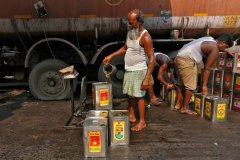India, having the status of the first most populous country in the world, has only 4.0% of the world's freshwater reserves. In addition, the production of drinking water in the country is hampered by environmental factors, including pollution of soils and local rivers, as well as limited reserves of artesian waters.
The volume of consumption of soft drinks in India in 2018-2022 was in the range of 14.0–18.0 million tons. The average annual consumption growth rate for 2018-2022 was 6.5%. In 2022, the total consumption of soft drinks peaked at 18.0 million tons.
The bottled water industry in India is a dynamic sector. Due to problems with the quality of tap water, against the background of growing attention to their own health, more and more Indians prefer to buy bottled water.
In 2022, bottled water accounted for 61.7% (11.1 million tons) of the total volume in the structure of consumption of soft drinks in the country. Carbonated drinks accounted for 20.7% (3.7 million tons).
Energy drinks are the most dynamically developing category of soft drinks. In 2018-2022, the volume of consumption of energy drinks increased 20—fold - from 19.2 thousand tons in 2018 to 385.7 thousand tons in 2022.
The increased interest in healthy nutrition has led to an increased demand for natural juices, especially those that do not contain added sugar. Juice products accounted for 14.8% of India's total soft drink consumption (2.7 million tons) in 2022.
India ranks second in the world after China in the production of vegetables and fruits, and also leads in the volume of harvested crops such as bananas and mangoes. The raw material needs of Indian juice producers are almost completely met by significant domestic production of fruits and vegetables. Meanwhile, some of the products continue to be purchased on foreign markets.
In 2022, the volume of consumption of juice products in India reached a peak in 5 years and amounted to 2.7 million tons, which is 8.5% more than in 2021. In 2018-2022, consumption of juice products increased by an average of 8.8% per year. The highest growth rates of consumption were recorded in 2019, when its volumes increased by 10.8%.
In 2022, the main share in the structure of consumption of juice products was occupied by juice drinks, which accounted for 77.3% (2.1 million tons) of the total volume. Nectars accounted for 21.2% of consumption (566.9 thousand tons).
The volume of nectar consumption in 2018-2022 increased annually by an average of 13.0% and increased from 347.8 thousand tons in 2018 to 566.9 thousand tons in 2022.
In 2022, natural juices accounted for 1.4% of the total consumption of juice products (37.9 thousand tons). In 2022, the consumption of natural juices increased by 15.2% compared to 2021. In 2018-2022, the demand for natural juices grew at an average annual rate of 12.6%. Natural juices from oranges, apples, guavas, grapes and mangoes are popular in India.
The most popular packaging sizes for juice products in India are packages of 1 liter (44.6% of consumption in 2022) and 250 ml (27.0%). Juice products in 200 ml packages accounted for 16.0% of the volume of sales in 2022, while the share of sales of products in 200 ml packages has been gradually increasing over the past five years. In 2022, juice products in packages of 50-150 ml accounted for 6.4% of total consumption. It is worth noting that in 2020-2021, the share of beverages in 50-150 ml packages decreased to 5.9% due to the COVID-19 pandemic.
The main type of packaging for juice products in India is solid plastic packaging, which accounted for 45.9% of the volume in 2022. Also popular types of packages are tetrapack (41.2%) and glass bottle (11.7%). Aluminum cans accounted for the smallest share of the volume of sales of juice products (1.2%).
Coca-Cola held the main share (27.9%) in the juice market in India in 2022. The second largest producer in terms of sales was the Indian manufacturer Parle Agro, which accounted for 19.0% of the market. PepsiCo held another 12.4% of the Indian juice market, Dabur India 8.7% and Tropicana Brands 5.3%. In total, the top 5 manufacturing companies accounted for 73.3% of the sales of juice products in India in 2022.
In 2022, India's imports of juice products amounted to 25.8 thousand tons in the amount of 42.7 million US dollars, which is 18.9% (6.0 thousand tons) less than the level of 2021 in volume and 5.5% (2.5 million US dollars) in value. In 2018-2022, Indian imports of juice products decreased on average annually by 4.1% in volume and by 2.8% in value.
The main types of imported juice products of India in 2022 were concentrated juices (60.8% of the volume of supplies in volume), natural juices (21.3%), as well as orange pulp (12.1%). At the same time, India mainly bought concentrated apple juice (50.5% of total imports of concentrated juice) and orange juice (24.1%) from China, Turkey and Brazil.
The main types of imported natural juices in 2022 were aloe juice (with the addition of other juices, such as peach and mango) from EU countries, orange juice from Egypt and coconut water from Thailand.
In the structure of Indian imports of juice products in volume by the end of 2022, China took the leading position, supplying 7.3 thousand tons of products to India, which amounted to 28.2% of the total volume of imports of juice products to the country. Israel took the second place with a share of 9.0%. Turkey is in third place with a share of 8.5%. In total, the top 10 exporting countries accounted for 84.3% of India's juice imports.
During the year, India increased purchases of juice products from Thailand by 56.9% (+531.1 tons) and Egypt by 51.3% (+368.7 thousand tons). Imports from China (-29.4% or -3.0 thousand tons), Israel (-51.1% or -2.4 thousand tons), Iran (-62.9% or -1.6 thousand tons) and Turkey (-30.2% or -948.8 tons) significantly decreased.
The main exporter of juice products to India in value terms in 2022 was China, which supplied juice products worth 8.8 million US dollars (20.5% of Indian juice imports). The three leading suppliers of juice products to India in value terms also included the Netherlands (13.9%) and Israel (12.8%). In total, the top 10 exporting countries accounted for 83.1% of the value of imports
current products of India.
The largest increase in exports in 2022 compared to the previous year was demonstrated by Thailand (+88.5% or +1.2 million US dollars), the Netherlands (+18.9% or +944.4 thousand US dollars) and Belgium (2.3 times or +755.6 thousand US dollars).
At the same time, supplies from Israel (-34.7% or -2.9 million US dollars), China (-24.3% or -2.8 million US dollars) and Iran (-57.5% or -1.3 million US dollars) significantly decreased.
In 2022, the average import price of juice products increased by 16.5% to 1,652 US dollars per ton. The most expensive products were supplied from the Netherlands at a price of $3,192 per ton, which is 93.2% higher than the average import price. Belgium (62.3% higher than the average price) and Israel (42.3% higher) also supplied expensive products. The cheapest products were purchased in Iran — US$ 1,043 per ton (36.9% lower than the average price), Turkey (28.4% lower) and China (27.3% lower).















